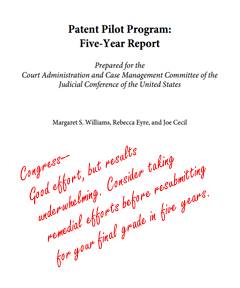A Suggestion Following the Disappointing Update on the Patent Cases Pilot Program
Five years ago, C ongress created the Patent Cases Pilot Program (PCPP) to increase the expertise of district court judges in patent cases. Yesterday, the Federal Judicial Center released its Five-Year Report on the PCPP, as required under the statute. The results were underwhelming. Where it counted, they were disappointing.
ongress created the Patent Cases Pilot Program (PCPP) to increase the expertise of district court judges in patent cases. Yesterday, the Federal Judicial Center released its Five-Year Report on the PCPP, as required under the statute. The results were underwhelming. Where it counted, they were disappointing.
On its face, the key value of the PCPP stemmed from its empirical approach to determining how the level of judicial expertise in patent law correlates with appellate reversal rates. Under the program, certain district courts designated certain judges as Pilot Judges. These district courts funneled patent cases to the Pilot Judges, in theory enabling these Pilot Judges to become more experienced in patent law than their non-Pilot-Judge colleagues.
Congress tasked the Federal Judicial Center with analyzing the effects of this increased expertise and preparing progress reports on its findings. According to the express language of the statute, the reports at years five and ten were to compare “the rate of reversal by the Court of Appeals for the Federal Circuit . . . on the issues of claim construction and substantive patent law” between Pilot and non-Pilot Judges.
The Five-Year report is 45 pages long and includes 33 tables. Yet as to the statutorily required analysis concerning reversals by the Federal Circuit, the Five-Year Report included little. Hampered by a lackluster data set, the authors concluded that “the substantive outcomes are not significantly different between affirmance and reversal” between Pilot and non-Pilot Judges. As to reversals specifically on claim construction the authors remained silent. Further, the authors expressed pessimism that the Ten-Year Report would provide additional insight. They concluded that “further investigation of appellate court decisions of pilot cases is unlikely to produce fruitful results.” In other words, a key—if not the primary—purpose of the PCPP likely will not be realized.
A few years ago, I wrote an article entitled, “On Measuring the Expertise of Patent-Pilot Judges: Encouraging Enhancement of Claim-Construction Uniformity.” I explained that Congress apparently created the PCPP having hypothesized that greater patent-law experience among district judges should correlate with a lower reversal rate at the Federal Circuit. The PCPP was therefore modeled as an experiment to test this hypothesis. Although the hypothesis and the structure of the experiment appeared reasonable, I concluded that this experiment would likely be unable to produce data from which the hypothesis could be evaluated. Specifically, I determined that there existed a confounding source of systematic error in the experiment. The source of this error was, and remains, two divergent approaches to claim construction condoned by the Federal Circuit.
Much has been written about the Federal Circuit’s inconsistent approaches to claim construction, including by the Federal Circuit’s own Judge Kimberly Moore in her dissent from an order denying rehearing en banc in Retractable Technologies, Inc. v. Becton, Dickenson & Co. I won’t belabor the point here except to note that the case of Marine Polymer Technologies, Inc. v. Hemcon, Inc. remains a stark reminder of this intra-circuit disagreement. In Marine Polymer, the en banc Federal Circuit split 5 to 5 on the issue of claim construction because the ten judges could not agree on the correct approach to claim construction.
Because “the name of the game is the claim,” and the rules to this game remain unclear, it may have been unrealistic for Congress to launch the PCPP expecting that reliable conclusions could be drawn from a study of appellate reversal rates. Perhaps Congress will take note of the Five-Year Report’s authors’ belief that further investigation of appellate decisions will not be fruitful. If so, perhaps Congress will attempt to right the PCPP ship. I suggest that they do so by addressing the claim-construction divide at the Federal Circuit. The Ten-Year Report might prove quite fruitful if its analysis could be based on nearly five years of reversal-rate data collected during a period in which there exists a single claim-construction framework.
Comments
Tags: Claim Construction, Congress, Pilot Program
